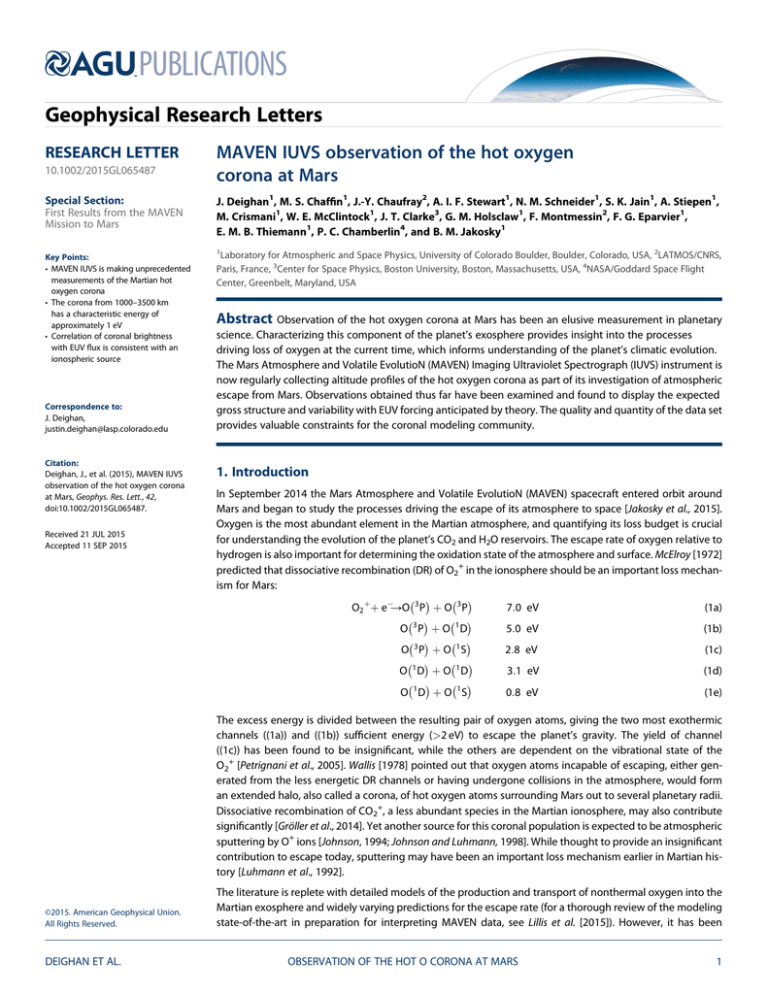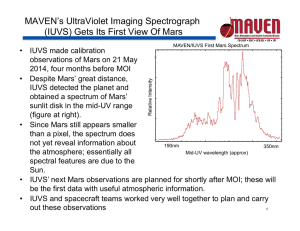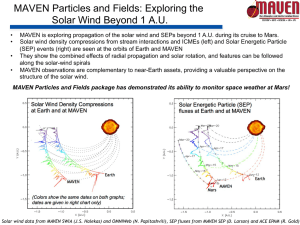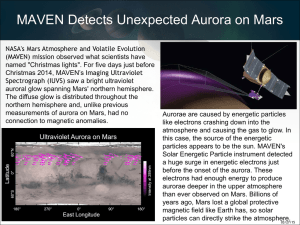
PUBLICATIONS
Geophysical Research Letters
RESEARCH LETTER
10.1002/2015GL065487
Special Section:
First Results from the MAVEN
Mission to Mars
Key Points:
• MAVEN IUVS is making unprecedented
measurements of the Martian hot
oxygen corona
• The corona from 1000–3500 km
has a characteristic energy of
approximately 1 eV
• Correlation of coronal brightness
with EUV flux is consistent with an
ionospheric source
Correspondence to:
J. Deighan,
justin.deighan@lasp.colorado.edu
Citation:
Deighan, J., et al. (2015), MAVEN IUVS
observation of the hot oxygen corona
at Mars, Geophys. Res. Lett., 42,
doi:10.1002/2015GL065487.
Received 21 JUL 2015
Accepted 11 SEP 2015
MAVEN IUVS observation of the hot oxygen
corona at Mars
J. Deighan1, M. S. Chaffin1, J.-Y. Chaufray2, A. I. F. Stewart1, N. M. Schneider1, S. K. Jain1, A. Stiepen1,
M. Crismani1, W. E. McClintock1, J. T. Clarke3, G. M. Holsclaw1, F. Montmessin2, F. G. Eparvier1,
E. M. B. Thiemann1, P. C. Chamberlin4, and B. M. Jakosky1
1
Laboratory for Atmospheric and Space Physics, University of Colorado Boulder, Boulder, Colorado, USA, 2LATMOS/CNRS,
Paris, France, 3Center for Space Physics, Boston University, Boston, Massachusetts, USA, 4NASA/Goddard Space Flight
Center, Greenbelt, Maryland, USA
Abstract Observation of the hot oxygen corona at Mars has been an elusive measurement in planetary
science. Characterizing this component of the planet’s exosphere provides insight into the processes
driving loss of oxygen at the current time, which informs understanding of the planet’s climatic evolution.
The Mars Atmosphere and Volatile EvolutioN (MAVEN) Imaging Ultraviolet Spectrograph (IUVS) instrument is
now regularly collecting altitude profiles of the hot oxygen corona as part of its investigation of atmospheric
escape from Mars. Observations obtained thus far have been examined and found to display the expected
gross structure and variability with EUV forcing anticipated by theory. The quality and quantity of the data set
provides valuable constraints for the coronal modeling community.
1. Introduction
In September 2014 the Mars Atmosphere and Volatile EvolutioN (MAVEN) spacecraft entered orbit around
Mars and began to study the processes driving the escape of its atmosphere to space [Jakosky et al., 2015].
Oxygen is the most abundant element in the Martian atmosphere, and quantifying its loss budget is crucial
for understanding the evolution of the planet’s CO2 and H2O reservoirs. The escape rate of oxygen relative to
hydrogen is also important for determining the oxidation state of the atmosphere and surface. McElroy [1972]
predicted that dissociative recombination (DR) of O2+ in the ionosphere should be an important loss mechanism for Mars:
7:0 eV
(1a)
O2 þþ e→O 3 P þ O 3 P
5:0 eV
(1b)
O 3P þ O 1D
3
1
2:8 eV
(1c)
O P þO S
1
1
3:1 eV
(1d)
O D þO D
1
1
0:8 eV
(1e)
O D þO S
The excess energy is divided between the resulting pair of oxygen atoms, giving the two most exothermic
channels ((1a)) and ((1b)) sufficient energy (>2 eV) to escape the planet’s gravity. The yield of channel
((1c)) has been found to be insignificant, while the others are dependent on the vibrational state of the
O2+ [Petrignani et al., 2005]. Wallis [1978] pointed out that oxygen atoms incapable of escaping, either generated from the less energetic DR channels or having undergone collisions in the atmosphere, would form
an extended halo, also called a corona, of hot oxygen atoms surrounding Mars out to several planetary radii.
Dissociative recombination of CO2+, a less abundant species in the Martian ionosphere, may also contribute
significantly [Gröller et al., 2014]. Yet another source for this coronal population is expected to be atmospheric
sputtering by O+ ions [Johnson, 1994; Johnson and Luhmann, 1998]. While thought to provide an insignificant
contribution to escape today, sputtering may have been an important loss mechanism earlier in Martian history [Luhmann et al., 1992].
©2015. American Geophysical Union.
All Rights Reserved.
DEIGHAN ET AL.
The literature is replete with detailed models of the production and transport of nonthermal oxygen into the
Martian exosphere and widely varying predictions for the escape rate (for a thorough review of the modeling
state-of-the-art in preparation for interpreting MAVEN data, see Lillis et al. [2015]). However, it has been
OBSERVATION OF THE HOT O CORONA AT MARS
1
Geophysical Research Letters
10.1002/2015GL065487
Figure 1. (a) Observational geometry of MAVEN IUVS coronal scans during the outbound segment of the orbit. The instrument
line of sight is inertially aligned with the semiminor axis and typically spans tangent altitudes of 400–3500 km. (b) Planetary
coverage of the coronal scan tangent point in Mars Solar Orbital (MSO) coordinates from November 2014 to March 2015 (orbits
236–812). Shaded regions indicate the night hemisphere, and each symbol represents a nominally executed coronal scan.
difficult to obtain the conclusive observations of the tenuous corona needed to validate these
models. Remote sensing measurements focus on resonant scattering of sunlight by the relatively strong
O I 130.4 nm triplet, but even so, the expected brightness at altitudes > 700 km where the hot population
dominates is on the order of 1–10 Rayleighs. The most successful previous efforts include a single profile
obtained by the Rosetta-Alice UV Imaging Spectrograph during a Mars flyby maneuver [Feldman et al.,
2011] and a pair of spectra taken using the Hubble Space Telescope Imaging Spectrograph [Carveth et al.,
2012]. These measurements suggested a transition in scale height from a cold thermal oxygen population
to a more energetic component at altitudes > 500 km. However, they struggled with issues of altitude
sampling and signal to noise in isolating the characteristics of this hot population.
In this letter we report on observations of the hot oxygen corona at Mars as measured by the Imaging
Ultraviolet Spectrograph (IUVS) [McClintock et al., 2014] aboard the MAVEN spacecraft. IUVS is a highly
capable remote sensing instrument, with a separate image-intensified FUV channel to maximize signal and
reduce stray light for faint features at short wavelengths, like the O I 130.4 nm triplet. The initial data reveal
an unambiguous transition from the thermal to nonthermal oxygen population with high altitude resolution
and signal to noise. Details on the lower altitude thermal oxygen component observed by IUVS may be found
in Chaufray et al. [2015]. By coadding data from December 2014 to January 2015, an extended coronal brightness profile exceeding the altitude of 1 Mars radius is obtained. Preliminary analysis shows the anticipated
gross structure of the oxygen corona, as well as an apparent response to solar EUV input consistent with
an ionospheric source. The IUVS observations of the oxygen corona provide a groundbreaking data set for
constraining and informing models of atmospheric escape at Mars.
2. Observations
During nominal science operations IUVS acquires an individual oxygen coronal scan once every two or four
orbits, depending on the spacecraft observing scenario. For these observations the boresight of the instrument is aligned with the semiminor axis of the MAVEN orbit as the spacecraft travels toward apoapse
(Figure 1a). This draws the IUVS line of sight across tangent altitudes of approximately 400 to 3500 km over
26 min, during which time it acquires over 100 integrations.
For an ionospheric photochemical source, the hot oxygen corona is expected to be densest in the dayside
hemisphere. The evolution of the MAVEN orbit allowed for coronal scans with solar zenith angles (SZA) close
to or less than 90° from November 2014 until March 2015 (Martian LS = 230–300). During this time the line of
sight tangent point attained a minimum SZA of 38.6°, and explored local times from dusk to dawn in the
southern hemisphere (Figure 1b). Nominal data were acquired over a substantial portion of this period, with
occasional gaps due to sharing pointing control with other instruments, communication passes, solar KeepOut Zone constraints, calibration activities, and other irregularities. The IUVS FUV channel data set used here
is available as FITS files under the label “outbound” in the v02_r01 release to the Planetary Data System.
Coronal scans of hot oxygen are among the most sensitive measurements made by IUVS. To minimize
random noise introduced by dark current subtraction, a reference superdark detector image was created
by coadding 417 dark images acquired on the side segments of orbit 628, when IUVS was subject to a
DEIGHAN ET AL.
OBSERVATION OF THE HOT O CORONA AT MARS
2
Geophysical Research Letters
10.1002/2015GL065487
high-voltage constraint. This superdark was
then scaled by a multiplier + constant to
match the dark current level for each orbit
of observations.
Measurement of the 130.4 nm triplet oxygen feature is complicated by its proximity
and faintness relative to the Ly α line at
121.6 nm produced by the Martian hydrogen corona. There is a ratio of 1000 between
the brightness of the two features, and the
wing of the instrument line spread function
(LSF) emanating from Ly α conspicuously
underlies the 130.4 nm triplet (Figure 2). To
subtract this background an empirical 2-D
LSF for the spectral and spatial dimensions
Figure 2. An averaged IUVS spectrum of the Martian corona showing of the spectrograph was constructed. The
the hydrogen 121.6 nm and oxygen 130.4 nm resonance lines. The
LSF was composed by coadding coronal
spectrum was obtained by coadding 1925 spectra taken with tangent
altitudes > 1000 km and SZA < 90° when the FUV detector temperature spectra obtained with tangent altitude
> 1000 km, ensuring a consistent brightwas stable at <17°C, representing approximately 8 h of integration
time. The same data were used to create the LSF template described in
ness along the entrance slit and minimized
section 2. The gray line underlying the 130.4 nm feature indicates the
the oxygen signal. This approach allowed
exponential wing interpolation used for the LSF.
us to intrinsically account for variations in
performance across the detector, such as
flat field, slit tilt, change in focus, and spectral-spatial point spread function anisotropy. Spectra within this
data set were filtered for cosmic ray detector events by calculating the median absolute deviation of the
raw data numbers (DN) for each detector pixel for a robust estimator of typical variability and then removing
samples that fell outside of 3σ. The Ly α wing was spectrally interpolated across the region containing the O
130.4 nm feature using an exponential + constant function. The resulting LSF was used as a template in a multiple linear regression (MLR) fit applied to the hydrogen and oxygen features in DN after dark subtraction. This
produced an integrated DN for both emission features along with a propagated uncertainty. A similar method
is used for fitting emissions in thermospheric limb scans obtained by IUVS at periapse [Stevens et al., 2015].
The integrated DN was then converted to physical brightness in Rayleighs using sensitivities derived from
stellar observations obtained during MAVEN’s cruise phase. The current calibration for the FUV channel
carries a systematic uncertainty of 25%.
3. Results
3.1. Altitude Profiles
A useful oxygen brightness profile can be derived from an individual IUVS coronal scan. The transition in
slope from the cold thermal oxygen population at low altitudes to the hot population at higher altitudes
is readily discerned (Figure 3a). However, signal to noise degrades substantially at tangent altitudes
> 1500 km, and the MLR produces unreliable error bars for spectra containing cosmic ray detector events.
We obtained dramatic improvement by coadding several orbits and binning the sampled altitudes on a
regular grid (Figure 3b). Cosmic ray detector events were filtered out by applying the same method used
to coadd the LSF template described in section 2. The resulting profiles allow for a more robust analysis of
the hot population where sufficient scans with similar conditions are available. Perhaps the ultimate example
of this is the coaddition of 48 profiles from orbits 335–624, which had good spatial continuity in MSO coordinates and sampled tangent point SZA spanning 39–81° (Figure 3c). The result is an altitude profile that is
representative of the global average dayside corona. For reference, a g factor of 5.76 × 106 s1 is appropriate
for O I 130.4 nm at time these data were collected.
The gravitationally bound component of the hot oxygen population dominates coronal densities at the
altitudes measured here. Escaping oxygen atoms rapidly pass through this region on hyperbolic trajectories, going on to become the dominant component at altitudes > 4 Mars radii where reaction channel
DEIGHAN ET AL.
OBSERVATION OF THE HOT O CORONA AT MARS
3
Geophysical Research Letters
10.1002/2015GL065487
Figure 3. Altitude brightness profiles of coronal oxygen, with 3σ uncertainties in gray. This does not include the 25%
systematic IUVS calibration uncertainty. (a) A single profile from orbit 422 with native altitude sampling; (b) an averaged
profile using orbits 412, 414, 416, 422, and 426 binned at 100 km resolution; (c) an averaged profile using orbits 335–624
binned at 100 km resolution, approximating a global average. Each altitude bin represents 30–40 min of integration time.
((1d)) has insufficient energy to reach. Though it is somewhat dubious to ascribe a temperature to the nonMaxwellian bound hot oxygen population, assigning a characteristic energy is not inappropriate. The
simplest model is that of a monoenergetic bound population with local spherical symmetry, which is then
integrated through for a range of line of sight tangent altitudes to obtain a column density profile. Because
the 130.4 nm line is optically thin in the corona, the slope of this column density profile can be directly
related to the brightness profiles obtained from IUVS. We neglect here the illumination contributed by
130.4 nm light reflected back upward from the optically thick cold oxygen. Using this simple model and
performing a least mean squares fit to the global average profile from 1000–3500 km, we find that the
observations are best reproduced by a population originating in the ionosphere with a characteristic kinetic
energy of 1.1 eV. This value is consistent with non-thermal oxygen atoms being produced by dissociative
recombination of O2+ (equation (1a)–(1e)) and undergoing a small number of collisions before reaching
the exosphere. Agreement in slope between predicted and IUVS observed brightness profiles has also been
found in a preliminary comparison using the detailed M-AMPS model [Lee et al., 2015].
3.2. Coronal Correlation With Solar EUV Input
Since dissociative recombination of ions on the topside of the ionosphere is thought to be the primary source
of hot oxygen at Mars, it is reasonable to expect that the coronal density would respond to variations in the
solar input of ionizing radiation. Fortunately, as part of its payload the MAVEN mission carries the EUVM
instrument [Eparvier et al., 2015], which is designed to monitor solar output with three photodiode channels
at selected wavelengths. Of these, channel A, which covers 17–22 nm, is the most direct proxy for the incident
photoionizing solar flux at Mars.
The time period from orbits 335–438 (2014 day of year 335–355) was found to have good data coverage by
both EUVM and IUVS, as well as containing the majority of a solar rotation period. This made it attractive for
investigating correlations between coronal oxygen and solar input. The average brightness of the 130.4 nm
triplet from 700–1500 km was taken as an indicator of the hot coronal density for individual orbits. Our results
are not very sensitive to the exact altitude range used, as long as it is from the region where hot oxygen
dominates and there is sufficient signal. We then compared the IUVS data with daily averages for the
calibrated EUVM 17–22 nm flux and the solar 130.4 nm emission derived from the FISM model
DEIGHAN ET AL.
OBSERVATION OF THE HOT O CORONA AT MARS
4
Geophysical Research Letters
10.1002/2015GL065487
[Chamberlin et al., 2007; Thiemann et al., 2014].
Coronal oxygen brightness is expected to vary positively with both of these solar inputs: the first because
it produces the ions necessary for dissociative recombination and the second because it is the source of
illumination for the oxygen resonance line scattering
that IUVS observes.
Acknowledgments
This work was funded by NASA through
the MAVEN project. A. Stiepen is
supported by the Belgian American
Educational Foundation and the Rotary
District 1630. Results presented here and
in the accompanying papers represent
the work of hundreds of scientists and
engineers who designed, built, and
operated the spacecraft and instruments
and carried out the scientific analyses.
We thank the two anonymous reviewers
for their valuable comments and
suggestions. The data used are archived
in the Planetary Atmospheres Node of
the Planetary Data System (http://pdsatmospheres.nmsu.edu).
The Editor thanks two anonymous
reviewers for their assistance in
evaluating this paper.
DEIGHAN ET AL.
Figure 4. Comparison of the FISM model solar 130.4 nm
brightness, the EUVM measured 17–22 nm solar flux, and
IUVS observations of the 130.4 nm resonance line scattered from the Martian hot oxygen corona. (a) A time series
of the three variables over the majority of a solar rotation
period, demonstrating that the coronal brightness tends
to track the solar flux at 17–22 nm. IUVS observations are
shown with 1σ uncertainties. (b) Linear regression of the
two solar inputs with the coronal brightness.
The details of our comparison are shown in Figure 4.
Incidentally, the solar 130.4 nm line and EUV emissions
were anticorrelated during the selected period. There
is also a clear upward trend in the IUVS brightness,
some part of which is likely due to the monotonic
decrease in SZA from 80.8° to 56.8° over this time.
Detailed modeling is required to accurately quantify
this systematic. The current data set suggests that variations in the brightness of the hot coronal oxygen
population at Mars are more closely associated with
changes in ionizing solar EUV flux rather than the illuminating solar 130.4 nm line. This is not particularly
surprising, as the EUV flux naturally exhibits a significantly greater variability than the 130.4 nm solar line.
What is important is that these variations derive from
fluctuations in the ionospheric generation of hot oxygen. By extension, these observations by IUVS and
EUVM provide insight into the underlying physics driving variations in the escape rate of atomic oxygen from
Mars at the present day. This is valuable for modelers
who seek to understand the upper atmosphere under
varying external forcings in order to more reliably
extrapolate loss to space through Martian history.
However, it is also a cautionary result in that care must
be taken to account for changes in solar input when
comparing models to observations made at different
times in the MAVEN mission.
4. Conclusion
We have presented the first observations of the hot
oxygen corona by MAVEN IUVS. These measurements
confirm the presence of this long anticipated feature
of the Martian exosphere and offer an invaluable way of probing the mechanisms driving escape of atomic
oxygen at the present day. Correlation with EUVM measurements suggests a relationship between coronal
density and solar photoionizing flux, supporting the expectation that dissociative recombination in the ionosphere is the primary source of hot oxygen at Mars. A variety of future studies are possible with the extensive
coronal oxygen data set that IUVS has begun to acquire. These include validation of decades of theoretical
modeling effort, a search for the signature of atmospheric sputtering, and ascertaining the effect of loss to
space on the atmospheric evolution of Martian CO2 and H2O reservoirs.
References
Carveth, C., J. T. Clarke, J.-Y. Chaufray, and J.-L. Bertaux (2012), Analysis of HST spatial profiles of oxygen airglow from Mars, B.A.A.S.
Chamberlin, P. C., T. N. Woods, and F. G. Eparvier (2007), Flare Irradiance Spectral Model (FISM): Daily component algorithms and results,
Space Weather, 5, S07005, doi:10.1029/2007SW000316.
Chaufray, J. Y., et al. (2015), Study of the Martian cold oxygen corona from the OI 130.4nm by IUVS/MAVEN, Geophys. Res. Lett., 42,
doi:10.1002/2015GL065341.
OBSERVATION OF THE HOT O CORONA AT MARS
5
Geophysical Research Letters
10.1002/2015GL065487
Eparvier, F. G., P. C. Chamberlin, T. N. Woods, and E. M. B. Thiemann (2015), The solar extreme ultraviolet monitor for MAVEN, Space Sci. Rev.,
doi:10.1007/s11214-015-0195-2.
Feldman, P. D., et al. (2011), Rosetta-Alice observations of exospheric hydrogen and oxygen on Mars, Icarus, 214, 394–399, doi:10.1016/
j.icarus.2011.06.013.
Gröller, H., H. Lichtenegger, H. Lammer, and V. I. Shematovich (2014), Hot oxygen and carbon escape from the Martian atmosphere, Planet.
Space Sci., 98, 93–105, doi:10.1016/j.pss.2014.01.007.
Jakosky, B. M., et al. (2015), The Mars Atmosphere and Volatile EvolutioN (MAVEN) Mission, Space Sci. Rev., doi:10.1007/s11214-015-0139-x.
Johnson, R. E. (1994), Plasma-induced sputtering of an atmosphere, Space Sci. Rev., 69, 215–253, doi:10.1007/BF02101697.
Johnson, R. E., and J. G. Luhmann (1998), Sputter contribution to the atmospheric corona of Mars, J. Geophys. Res., 103, 3649–3653,
doi:10.1029/97JE03266.
Lee, Y., M. R. Combi, V. Tenishev, S. W. Bougher, J. Deighan, N. M. Schneider, W. E. McClintock, and B. M. Jakosky (2015), A comparison of 3-D
model predictions of Mars′ oxygen corona with early MAVEN IUVS observations, Geophys. Res. Lett., 42, doi:10.1002/2015GL065291.
Lillis, R. J., et al. (2015), Characterizing atmospheric escape from Mars today and through time, with MAVEN, Space Sci. Rev., doi:10.1007/
s11214-015-0165-8, in press.
Luhmann, J. G., R. E. Johnson, and M. H. G. Zhang (1992), Evolutionary impact of sputtering of the Martian atmosphere by O(+) pickup ions,
Geophys. Res. Lett., 19, 2151–2154, doi:10.1029/92GL02485.
McClintock, W. E., N. M. Schneider, G. M. Holsclaw, J. T. Clarke, A. C. Hoskins, I. Stewart, F. Montmessin, R. V. Yelle, and J. Deighan (2014), The
Imaging Ultraviolet Spectrograph (IUVS) for the MAVEN Mission, Space Sci. Rev., doi:10.1007/s11214-014-0098-7.
McElroy, M. B. (1972), Mars: An evolving atmosphere, Science, 28, 443–445, doi:10.1126/science.175.4020.443.
Petrignani, A., W. J. van der Zande, P. C. Cosby, F. Hellberg, R. D. Thomas, and M. Larsson (2005), Vibrationally resolved rate coefficients and
+
branching fractions in the dissociative recombination of O2 , J. Chem. Phys., 122, 014302, doi:10.1063/1.1825991.
Stevens, M. H., et al. (2015), New observations of molecular nitrogen in the Martian upper atmosphere by IUVS on MAVEN, Geophys. Res. Lett.,
42, doi:10.1002/2015GL065319.
Thiemann, E., F. G. Eparvier, and P. C. Chamberlin (2014), FISM-P: A model of the vacuum ultraviolet irradiance spectrum for atmospheric
studies at Mars and beyond, Abstract P51B-3940 presented at 2014 Fall Meeting, AGU, San Francisco, Calif., 15–19 Dec.
Wallis, M. K. (1978), Exospheric density and escape fluxes of atomic isotopes on Venus and Mars, Planet. Space Sci., 26, 949–953, doi:10.1016/
0032-0633(78)90077-6.
DEIGHAN ET AL.
OBSERVATION OF THE HOT O CORONA AT MARS
6





